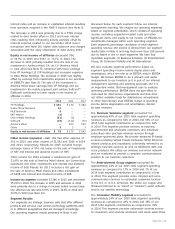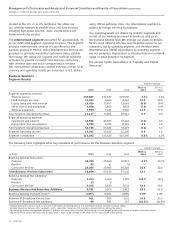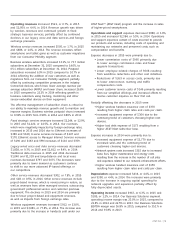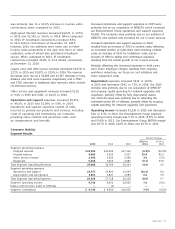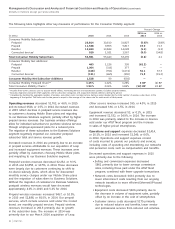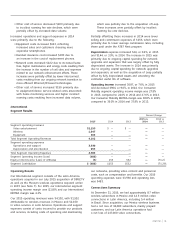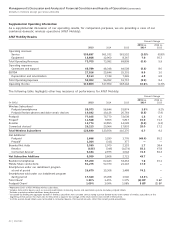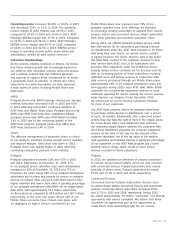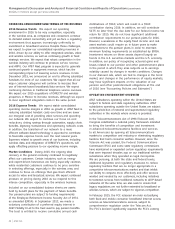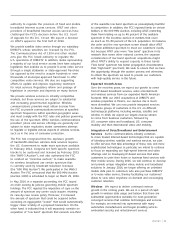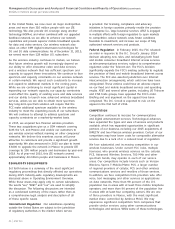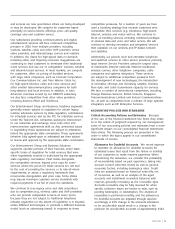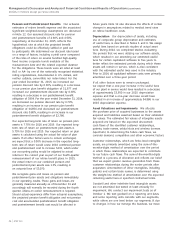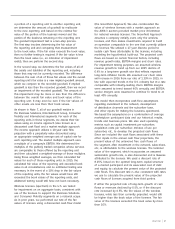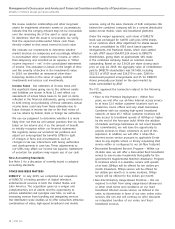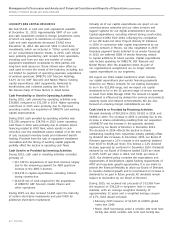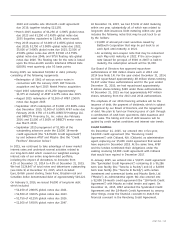AT&T Wireless 2015 Annual Report Download - page 24
Download and view the complete annual report
Please find page 24 of the 2015 AT&T Wireless annual report below. You can navigate through the pages in the report by either clicking on the pages listed below, or by using the keyword search tool below to find specific information within the annual report.
Management’s Discussion and Analysis of Financial Condition and Results of Operations (continued)
Dollars in millions except per share amounts
22
|
AT&T INC.
distributions of $560, which will result in a $560
contribution during 2016. In addition, we will contribute
$175 no later than the due date for our federal income tax
return for 2015. We do not have significant additional
contribution requirements to our pension plans for 2016.
However, a weakness in the equity, fixed income and real
asset markets could require us in future years to make
contributions to the pension plans in order to maintain
minimum funding requirements as established by ERISA.
Investment returns on these assets depend largely on
trends in the U.S. securities markets and the U.S. economy.
In addition, our policy of recognizing actuarial gains and
losses related to our pension and other postretirement plans
in the period in which they arise subjects us to earnings
volatility caused by changes in market conditions. Changes
in our discount rate, which are tied to changes in the bond
market, and changes in the performance of equity markets,
may have significant impacts on the valuation of our
pension and other postretirement obligations at the end
of 2016 (see “Accounting Policies and Estimates”).
OPERATING ENVIRONMENT OVERVIEW
AT&T subsidiaries operating within the United States are
subject to federal and state regulatory authorities. AT&T
subsidiaries operating outside the United States are subject
to the jurisdiction of national and supranational regulatory
authorities in the markets where service is provided.
In the Telecommunications Act of 1996 (Telecom Act),
Congress established a national policy framework intended
to bring the benefits of competition and investment
in advanced telecommunications facilities and services
to all Americans by opening all telecommunications
markets to competition and reducing or eliminating regulatory
burdens that harm consumer welfare. However, since the
Telecom Act was passed, the Federal Communications
Commission (FCC) and some state regulatory commissions
have maintained or expanded certain regulatory requirements
that were imposed decades ago on our traditional wireline
subsidiaries when they operated as legal monopolies.
We are pursuing, at both the state and federal levels,
additional legislative and regulatory measures to reduce
regulatory burdens that are no longer appropriate in a
competitive telecommunications market and that inhibit
our ability to compete more effectively and offer services
wanted and needed by our customers, including initiatives
to transition services from traditional networks to all IP-based
networks. At the same time, we also seek to ensure that
legacy regulations are not further extended to broadband or
wireless services, which are subject to vigorous competition.
In February 2015, the FCC released an order reclassifying
both fixed and mobile consumer broadband Internet access
services as telecommunications services, subject to
comprehensive regulation under the Telecom Act.
The FCC’s decision significantly expands the FCC’s existing
OPERATING ENVIRONMENT AND TRENDS OF THE BUSINESS
2016 Revenue Trends We expect our operating
environment in 2016 to be very competitive, especially
in the wireless area, as companies and consumers continue
to demand instant connectivity and yet we face a regulatory
environment that appears increasingly unfriendly to
investment in broadband services. Despite these challenges,
we expect to grow our consolidated operating revenues in
2016, driven by our ability to offer integrated wireless, video
and wireline services, as well as continuing growth in fixed
strategic services. We expect that robust competition in the
wireless industry will continue to pressure service revenue
and ARPU. Our AT&T Next program is expected to generate
continued growth in equipment revenue, which has the
corresponding impact of lowering service revenues. In late
December 2015, we announced an end to offering subsidized
handsets for most of our customers. We expect that all our
major customer categories will continue to increase their
use of Internet-based broadband/data services. We expect
continuing declines in traditional telephone service revenues.
We expect our 2015 acquisitions of DIRECTV and wireless
properties in Mexico to increase revenues, although we expect
to incur significant integration costs in the same period.
2016 Expense Trends We expect stable consolidated
operating income margins in 2016 as growth in AT&T Next is
reducing subsidized handset costs over time and we lower
our marginal cost of providing video services and operating
our network. We expect to continue our focus on cost
reductions, driving savings through automation, supply chain,
benefits, digitizing transactions and optimizing network costs.
In addition, the transition of our network to a more
efficient software-based technology is expected to contribute
to favorable expense trends over the next several years.
Expenses related to growth areas of our business, including
wireless data, and integration of DIRECTV’s operations, will
apply offsetting pressure to our operating income margin.
Market Conditions During 2015, the ongoing slow
recovery in the general economy continued to negatively
affect our customers. Certain industries, such as energy
and export-driven businesses are being especially cautious
while residential customers continue to be price sensitive
in selecting offerings, especially in the wireless area, and
continue to focus on offerings that give them efficient
access to video and broadcast services. We expect continued
pressure on pricing during 2016 as we respond to this
intense competition, especially in the wireless business.
Included on our consolidated balance sheets are assets
held by benefit plans for the payment of future benefits.
Our pension plans are subject to funding requirements
of the Employee Retirement Income Security Act of 1974,
as amended (ERISA). In September 2013, we made a
voluntary contribution of a preferred equity interest in
AT&TMobilityIILLC to the trust used to pay pension benefits.
The trust is entitled to receive cumulative annual cash



